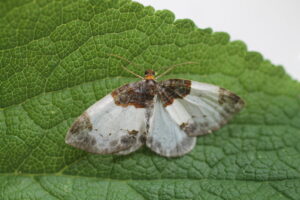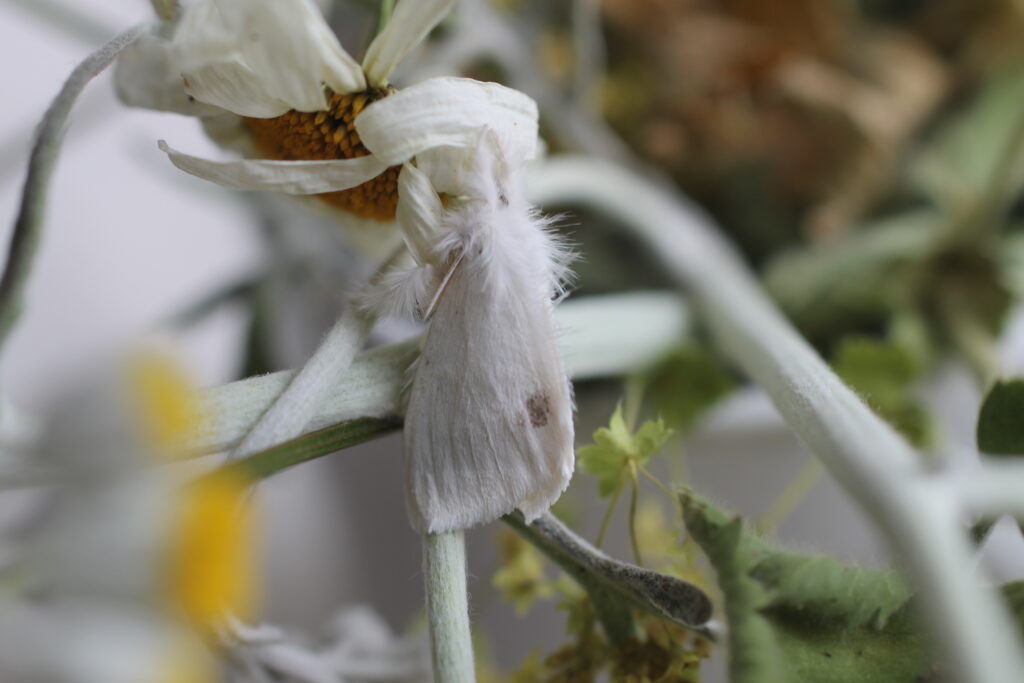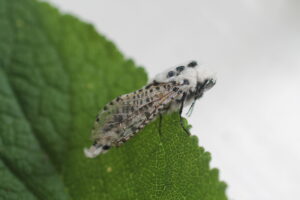12 July 2025
Glamour in the Dark: Two Newcomers Arrive at Shandy Hall
When I moved to Shandy Hall for my summer internship, I imagined something quiet, bookish, maybe a few dusky moths fluttering lazily around old lamps. What I didn’t expect was to be flung headfirst into a Gatsby-esque whirlwind of creatures in velvet and brocade, each more eccentric and dazzling than the last. If this summer’s moth scene were a party, I was just the newest guest, joining a decade-long parade of interns who came before me, now ushering in the moth’s version of the roaring twenties.
Due to the unrelenting wind and cloud that Yorkshire insisted on sending our way, the first act of this nocturnal soirée had to be moved indoors. There, beneath the cover of the shade and the scrutiny of moth guides, I was introduced to my summer companions: tiny, winged characters full of personality, history, and mystery.

The first moth that Patrick handed me was dubbed “unmistakable” by the moth guide, and after squinting through a hand lens at its elaborate brown-and-cream patterning, I could see why. It was my first real ID, my first introduction, and somehow that felt fitting. I was the new intern; it was a new species for Shandy Hall. We were both newcomers to the party.
Despite its name, the Beautiful Carpet isn’t the social butterfly you might expect. It’s a bit of a loner—sluggish, quiet, often found resting during the day rather than circling the evening’s light traps with the others. After waking up far earlier than I’m used to, I could relate (I wasn’t exactly darting toward the action either).
Carpet moths, I learned, take their name not from an appetite for our rugs (a myth I fully bought into at first) but from their intricate wing patterns, designs so marvelous they resemble Persian tapestries or Victorian wallpaper. These moths rest with their wings spread flat, showing off every thread of their design, unlike many others who tent their wings shyly. You could say they know how to work the room.
This particular species gets its name from its bold coloring: Mesoleuca combines the Greek words for “middle” (mesos) and “white” (leukos), referencing the bright band across its forewings. The species name, albicillata, comes from Latin—albi- (white) and -cillata (fringed)—again nodding to that same stark, clean patterning.
They belong to the Geometridae family, known for inchworm larvae that appear to “measure the earth” with their looping gait. It’s a testament to the poetic eye of early naturalists. Few descriptions capture behavior so precisely and lyrically.

But no sooner had I settled into the slow, dreamy elegance of the Beautiful Carpet when another guest began flouncing about, trailing a feather boa and demanding attention.
The Yellow-tail was impossible to ignore. Barely 20mm across, it was a flash of white and gold, flitting frantically in its jar like a miniature flapper dancer caught mid-twirl. This moth did not want to be photographed, at least not on anyone else’s terms. Eventually, it struck a dramatic pose on a cluster of flowers, wings steeply folded like the pitched roof of a miniature cathedral. A drama queen, through and through.
The name Euproctis similis has quite the backstory (pun not intended). Eu- means “good,” and proctis comes from the Greek prōktos, referring to the conspicuous tuft of golden anal hairs at the tip of its abdomen. The species name similis refers to the fact that its wings are for the most part unmarked, a blank canvas punctuated by that striking yellow flourish.
That tuft is more than decorative. In females (who are larger than males), the hairs are used to cover egg clusters, helping to protect the larvae when they first emerge. Those caterpillars don’t mess around either: they’re covered in defensive, irritating hairs and should never be handled casually. Each one builds its own solitary silk tent for the winter, unlike the more gregarious Brown-tail caterpillars, which bunk together in shared shelters.
When disturbed, the adult moth will suddenly drop to one side and play dead. A classic theatrical move, worthy of any stage.
Cameos from the Night Crowd
Of course, no good party is complete without a few scene-stealers drifting through the crowd. That night, we had several repeat guests and even a few surprise VIPs.
There was no missing the Elephant Hawkmoth (Deilephila elpenor), several of which showed up in style. With their shocking pink and olive green coloring, they looked like they’d walked straight out of an Art Deco cocktail lounge. A rarer visitor was the Leopard Moth (Zeuzera pyrina). With its sleek white wings speckled in black, it looked like it had come dressed for the Jazz Age, right down to the fur collar. The classic Peppered Moth (Biston betularia) also made an appearance, with a reputation rooted in industrial-era drama and natural selection lore. And glinting under the light was the Burnished Brass (Diachrysia chrysitis), whose metallic, golden-green wings shimmered like a flapper’s dress under stage lights.

Every moth I meet here has its own style, its own rhythms and rituals. Some dazzle. Some hide. Some startle you with a sudden twist of color; others sit quietly on a leaf, perfectly camouflaged, waiting to be noticed. As the newest guest at the party, I’m still learning the rules. But if this first week has shown me anything, it’s that the elusive world of moths can provide more than enough entertainment when given the right amount of attention.
Here’s to the rest of the summer—and the rest of the guest list (455 and counting!).
Post by Sophia Hernandez (UPenn intern)
Recent Moths
- Rise of the AI Naturalist
- Best Moths for a Haunted Abbey
- The Real and Fake Deaths of Moths
- The Colonizers of Yorkshire
- Glamour in the Dark: Two Newcomers Arrive at Shandy Hall
- 25 July 2023 – Collective Noun for Hawkmoths
- MOTH LIST to August 2023 with links
- 28 July 2023 – TRIPLE New Species Alert!
- 18 July 2023 – A Golden…Plusia!
- 13 July 2023 – Arts and Sciences
- 10 July 2023 – Rise of the Yellow Underwings
- 4 July 2023 – Cold-weather Catch






